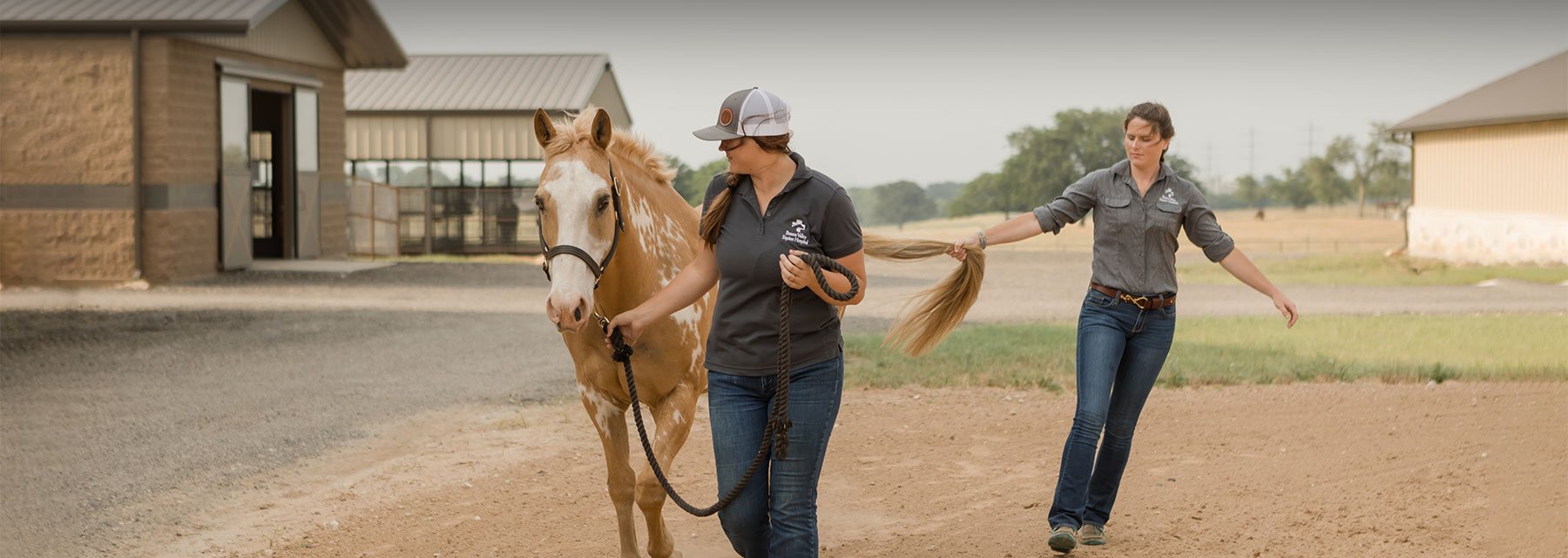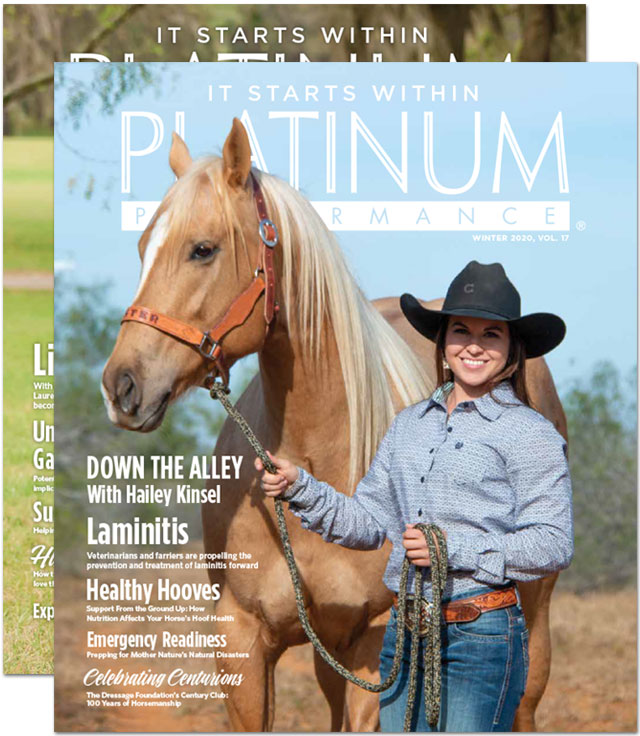Learning From 2022, Experts are Refining How Veterinarians and Riders can Respond to Future Equine Herpesvirus Outbreaks and, Better Yet, Prevent Them
Riders seem to receive news of a viral outbreak in their horses the same way a moviegoer might react to a horror flick: fear and uncertainty; especially when the virus is equine herpesvirus or, more specifically, EHV-1. Such was the case in February 2022 when the equine world was again gripped by a confirmed outbreak of EHV-1 originating at Desert International Horse Park near Palm Springs, California, and spreading throughout the western U.S. from there. Equine veterinarians learned a great deal from this latest event and are working to better refine how veterinarians and riders can respond to future outbreaks and, more importantly, better prevent them from occurring.
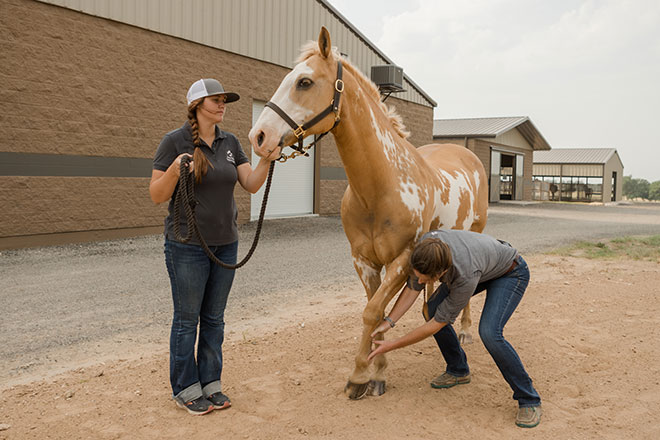
PHOTO BY ELIZABETH HAY PHOTOGRAPHY
“The key things to remember about EHV are that, No. 1, it’s an important virus; No. 2, it’s ubiquitous; and No. 3, it causes latent infection. Also, it can manifest in several ways.”
— Steve Reed, DVM, DACVIM,
Rood & Riddle Equine Hospital
Understanding Equine Herpesvirus
Equine herpesvirus is a highly infectious member of the family alphaherpesviridae found virtually worldwide. There are currently nine known alphaherpesviruses. EHV-1, EHV-3 and EHV-4 are known to put horses at the greatest risk with symptoms that are unique to each form of the disease. According to the American Association of Equine Practitioners (AAEP), EHV-1 can bring on respiratory disease as well as abortion and neonatal death, in addition to the potentially- deadly neurologic form of the disease, known as equine herpesvirus myeloencephalopathy (EHM). EHV-3, in comparison, causes transmissible venereal disease affecting horses’ external genitalia but has not been shown to impact fertility rates. Lastly, EHV-4 causes respiratory symptoms in both adult horses and foals that typically present as milder than those seen with EHV-1. “Equine herpesvirus is a pretty ubiquitous virus,” explains Dr. Steve Reed, veterinarian, boarded internal medicine specialist and legend in the field. Dr. Reed has practiced for decades with the renowned team at Rood & Riddle Equine Hospital, in Lexington, Kentucky, where he is a famed equine neurology expert and was also chosen to present the Frank J. Milne State-of-the-Art Lecture at AAEP’s 2008 convention to a global audience of veterinarians on the subject of equine neurology. Dr. Reed has had significant experience with equine herpesvirus cases and the virus’s unique characteristics. “One of the most interesting things about EHV is that once horses are exposed to it, they’ll often develop a latent infection,” he continues. “Horses will retain the virus, and there’s some debate as to whether it’s in lymphocytes or in the trigeminal ganglion.” Either way, an overwhelming percentage of horses have been exposed to EHV and carry a latent form of the virus, with a significantly smaller number ever developing active virus and subsequent respiratory symptoms, let alone neurologic signs.
The equine community is understandably fearful of EHV-1, but more so of EHM, the often-fatal neurologic form of the disease known to cause significant vascular damage by injuring the lining of blood vessels in the central nervous system. According to the AAEP, “Neurologic signs (of EHM) result from inflammation of the blood vessels, blood clots and death of neurologic tissue. Cases of EHM occur singly or can affect multiple infected horses. They may or may not be associated with a previous or ongoing EHV-1 respiratory or abortion disease outbreak.” The unique aspects of EHM can be extremely detrimental to the horse and prove difficult to treat. “It’s not an ‘itis’; it’s actually an encephalopathy,” observes Dr. Reed. The vascular damage causes several stroke-like episodes in the animal that are responsible for causing EHM’s neurologic symptoms.
While there were confirmed cases of EHM during February’s outbreak, significantly more horses, which is typical in these scenarios, tested positive for EHV-1. “The key things to remember about EHV- 1 include: No. 1, it’s an important virus; No. 2, it’s ubiquitous; and No. 3, it causes latent infection. Also, it can manifest in several ways,” says Dr. Reed as a high-level summation. Those manifestations can begin within an incubation window spanning 24 hours to six days or longer. The AAEP cautions that affected horses will typically present with a fever on day one or two of infection and possibly again on day six or seven, with respiratory symptoms often including “serious or mucoid nasal and ocular discharge without a lot of coughing.” In addition, persistent enlargement of some lymph nodes (usually just below the lower jaw) is common. While these symptoms may indicate an EHV-1 infection, veterinarians will begin to suspect the neurological EHM when rapid onset of neurologic symptoms such as incoordination, hind limb weakness, lethargy, head tilt, urine leaking and recumbency. Interestingly, EHM symptoms often appear without concurrent respiratory symptoms and with only a fever as an early indicator before symptoms set in quickly and peak within 24-48 hours.
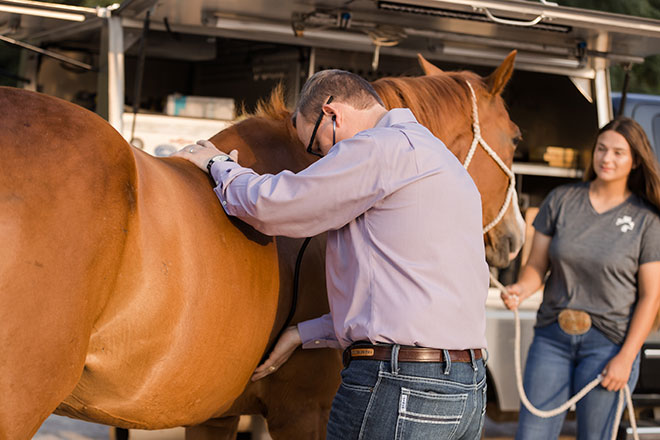
PHOTO BY ELIZABETH HAY PHOTOGRAPHY
According to the AAEP, “Neurologic signs (of EHM) result from inflammation of the blood vessels, blood clots and death of neurologic tissue. Cases of EHM occur singly or can affect multiple infected horses. They may or may not be associated with a previous or ongoing EHV-1 respiratory or abortion disease outbreak.”
Slowing the Spread
We’ve heard the term “slow the spread” far too often in recent years. It triggers a shiver in many people, surfacing memories from the COVID-19 pandemic and the resulting lifestyle changes. Understanding the epidemiology and behavior of a virus allows experts to better predict and prevent viral infection with unique strategies. In the case of EHV, the equine veterinary community has a much more solid foundation in terms of how it spreads, setting the stage for more effective preventive strategies. “I’ve learned so much during this whole process,” says Dr. Lori Bidwell of last February’s EHV-1 outbreak she experienced first-hand as an onsite veterinarian. The outbreak originated at the Desert International Horse Park, one of the largest equestrian facilities in North America, with nearly 1.6 million square feet of competition and riding space in Thermal, California. Dr. Bidwell is a widely-respected equine practitioner and boarded anesthesiologist, as well as a co-owner — along with her husband and fellow veterinarian Dr. Duncan Peters — of East-West Equine Sports Medicine with facilities in Kentucky and California. “It all started on Feb. 11, 2022,” says Dr. Bidwell of the beginning of one of the more severe EHV outbreaks the horse community has experienced. “The initial horse was showing fever, mild neurologic signs and weakness in the hind end. As soon as we noticed those clinical signs, we called the state veterinarian and immediately isolated that horse. There were 48 horses, I believe, in the barn where that initial horse came from. That barn was placed in quarantine.” Within three days two more horses presented with a fever. Those animals developed neurologic signs within 48 hours. On that fourth evening, one of the two new cases was euthanized due to the severity of its clinical signs. With quick action and biosecurity protocols, EHM cases only occurred in three horses, with all other confirmed EHV-1 cases presenting with a mild fever that would typically resolve within a matter of hours after a single dose of Banamine. “Any horse that had a fever would immediately be placed into a semi-isolation area until we received the test results,” explains Dr. Bidwell. “Then those horses were moved into isolation if they tested positive for EHV-1.” There were also cases with no clinical signs at all, yet they tested positive for EHV-1 nonetheless.
Nearly 30 horses were moved into isolation and by March 10, nearly a month later, all but four had been released. “It was a long process,” says Dr. Bidwell. “We were going through a phase where we’d have at least one new horse with a fever every single day. There were several horses that would not test positive on the initial test, but we would collect a second sample and they would then test positive.” Once the outbreak was discovered, Dr. Bidwell is convinced that the high number of cases were only detected because all horses on the premises had their temperatures monitored. “There are mild cases that are so easy to miss in horses that are never depressed looking, and that’s one thing that’s a little bit scary about this scenario; the horse looks great, but it’s positive for EHV-1.”
As Dr. Bidwell and the team at the Desert International Horse Park worked to contain the EHV-1 outbreak and treat affected horses, they began to really dissect the root cause of how the virus spread so quickly. Their observations added to those in the research community, providing a better glimpse into what causes viral equine transmission and how best to prevent this situation in the future. “Nose to nose contact is the No. 1 problem,” says Dr. Bidwell. “Unfortunately, there’s a lot of horse-to-horse contact at these shows. A lot of people walk the horses and allow them to touch nose to nose. It’s also very common to have a community water bucket and a big bin of carrots that horses can just go to and eat out of. Everyone from the barn is often sharing, so that creates our biggest problem.” Human interaction also played a role in spreading EHV among the horse population. “The virus can live on our clothing for seven to 30 days. It really made me stop and think. Before this happened, I didn’t wash my jacket every day. I certainly do now. I changed my clothes probably 10 times a day,” she says of the precautions she took during the outbreak.
Dr. Bidwell also observed that the social habits of grooms, trainers and riders contribute to the risk. Grooms and trainers travel from horse to horse, likely in the same clothes and boots, then also venture to other barns for socializing and “talking shop.” Most would counter that that’s part of the fun of a horse show. A horse show is a community where friends reunite, talk, laugh and gather around the barn with music playing and chairs in the shade. It’s now known that what most trainers, riders and grooms would see as simply socializing is actually creating the opportunity for a live virus to transfer from horse to horse with caregivers being the primary vessel. The question becomes, how do we keep horse shows fun, lively and engaging while also protecting horses from potential viral exposure at our unknowing hands?
“Unfortunately, there’s a lot of contact at these shows. A lot of people walk the horses and allow them to touch nose to nose. It’s also very common to have a community water bucket and a big bin of carrots that the horses can just go to and eat out of. Everyone from the barn is often sharing, so that creates our biggest problem.”
— Lori Bidwell, DVM, DACVA, East-West Equine Sports Medicine
Establishing Biosecurity Protocols
Prior to the February outbreak, the last major spread of EHV-1 occurred in Ogden, Utah, in the spring of 2011. The initial report stated that several horses that participated in the National Cutting Horse Association’s Western National Championships, held April 29 to May 8, had been diagnosed with EHV-1, and veterinarians in several states were evaluating the extent of the outbreak. Within weeks 90 animals in multiple western states were confirmed with EHV-1 or EHM. Thirteen horses died or were euthanized. Of the 54 horses at the championships, 28 were confirmed EHV-1, 26 were EHM and 10 animals ultimately died. Dr. Josie Traub-Dargatz was involved in a retrospective epidemiologic investigation of that outbreak. She and her fellow researchers had the goal of better understanding the incident to develop enhanced biosecurity recommendations and prevent future outbreaks, all the while identifying preventive strategies and treatments.
“I’ve seen an evolution in biosecurity within the equine industry throughout my career,” says Dr. Traub-Dargatz, an equine veterinarian and boarded internal medicine specialist, as well as a professor emeritus of clinical sciences at Colorado State University’s College of Veterinary Medicine and Biomedical Sciences in Fort Collins. “The major point is seen in having everyday biosecurity for events where horses come together. We recognize that when horses come together from different areas, they’re at a higher risk of exposure to a contagious disease agent than they might have been if they were at their home barn,” she explains. “Having protocols in place to avoid the spread of disease and the risk posed to horses on an everyday basis is important. I also think Dr. Reed’s comments are important. EHV-1 can reactivate from its latent state.” When that occurs, a horse then sheds the virus from their nasal secretions and may not show any outward signs of disease. “We wouldn’t know they’re sick, even if we were monitoring them very carefully. So having good hand hygiene protocols (for grooms and caregivers) between groups of horses — ideally even between each horse — is key, and we have to make that easy to do with hand washing or hand sanitizer stations,” suggests Dr. Traub-Dargatz. “In addition, and as Dr. Bidwell said, we also need to minimize direct horse-to-horse contact as much as we can while avoiding congregation of horses in locations such as entry gates, wash rack areas and water sources; definitely no sharing of water sources, buckets, tack, grooming equipment or wipe rags.” Prevention strategies, include clearly labeling buckets, grooming equipment and tack to prevent confusing which horse they belong to, using a color-coding system for each horse or group of horses under the same management and, obviously, monitoring for early signs of disease. Also, limiting the people who come into contact with each horse to only caregivers is helpful.
Beyond biosecurity protocols for preventing the spread of disease, establishing a clear-cut protocol in the event that disease occurs is arguably just as critical. “This enhanced biosecurity is designed to contain the disease in order to limit the number of animals impacted as much as possible,” says Dr. Traub-Dargatz. Protocols ideally need to be unique to each event or horse show, outlining what type of scenario or detection of disease would prompt a response, and clearly defining what the response would be. “When we recognize a horse or horses that pose a disease risk, getting them separated and into a place where we have the materials we need to allow the caretakers and veterinarians to get in and effectively care for those animals is important,” says Dr. Traub-Dargatz. “We must do that by not moving disease agents from those isolated animals to yet unexposed animals. Also, monitoring potentially-exposed animals for disease is key. For instance, monitoring for fever twice per day, then taking action based on the results.”
The 2011 and 2022 outbreaks further emphasized the need for clear and thoughtful biosecurity protocols to be in place wherever horses are brought together from different sources to enhance prevention and also to be ready to roll out in the event that contagious disease occurs.
Treatment Protocols
Treatment plans for EHV-positive horses need to be closely intertwined with biosecurity protocols as veterinarians work toward a favorable outcome in their patients, while limiting cross-contamination and infection in non-symptomatic horses. “The first thing we do is to get affected horses out of their current environment. Then it’s critical to pay close attention to those horses that were in immediate contact,” cautions Dr. Reed. “Once a positive or symptomatic horse has been separated, then we’ve got to start thinking long and hard about what we’re going to do. These horses can be febrile (presenting with a fever) in the morning, recumbent by mid-afternoon and on their way to death by midnight. It can be a really rapid progression of disease. That certainly tells us we had better do something rapidly. If the horse is febrile, we need to do something to combat that with a non-steroidal such as Banamine® or phenylbutazone (bute). We know from Dr. Bidwell that Banamine® was helpful in her EHV-positive cases this winter,” says Dr. Reed. “No. 2, because of the fact that there is vascular damage, there’s evidence that perhaps some anticoagulants might be helpful; in particular heparin, and that’s often a drug that I’ll go to. While it’s a helpful drug in my experience, it may not work for everyone. Certainly, we know now that some antiviral agents also have the potential to be very helpful as well. It’s critical for the veterinarians to be aware of what drug is absorbed well and what isn’t when they’re considering which drugs to use,” Dr. Reed says. “There’s been some work by Dr. Gisela Soboll Hussey at Michigan State University showing that stacking too many drugs on top of each other is not always helpful, so we need to be tuned in and have a definitive plan.”
Dr. Bidwell’s approach on the ground during this most recent EHV outbreak is certainly in line with Dr. Reed’s suggested approach. She and her team immediately administered 21 one gram tabs of valacyclovir three times a day for two weeks, heparin subcutaneously twice-daily for three days, as well as an IV bag of DMSO (dimethyl sulfoxide) twice-daily for three days. “That was our treatment method, and we tried to be pretty aggressive as soon as we had a horse with a fever,” confirms Dr. Bidwell.
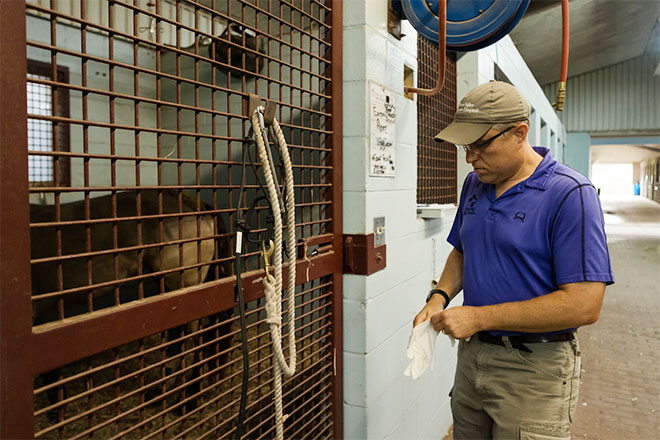
PHOTO BY ELIZABETH HAY PHOTOGRAPHY
“We actually learned that zinc supplementation influenced risk in the horse population we studied.”
— Josie Traub-Dargatz, DVM, DACVIM,
Colorado State University
Rick Factors and Preventive Measures
While there have been other EHV-1 outbreaks between 2011 and 2022, Dr. Traub-Dargatz and her researchers analyzed data from the 2011 outbreak to provide recommendations for more successful treatments and preventive strategies. “That outbreak spanned multiple states and revolved around horses that had attended a cutting horse event in Ogden,” explains Dr. Taub-Dargatz. Unlike the 2022 incident, the horses had actually left the show in Ogden to return home to multiple other locations by the time the first EHM case was confirmed in Colorado. Eventually, 19 U.S. states and some Canadian provinces had a mix of confirmed cases and exposed horses. Dr. Traub-Dargatz and team surveyed owners of EHV-positive horses and unaffected animals used as controls, looking for specific factors tied to horses becoming EHV-1 or EHM cases. “The survey was quite extensive, and we did a statistical comparison to determine factors that were associated with EHV-1 cases compared to EHM cases,” explains Dr. Traub-Dargatz. “Those factors were gender, with female horses being over-represented in the EHM cases, as well as the number of biosecurity risks that each horse encountered while they were at the event and also the number of classes the horse was in during the (championships). Then, when we compared EHM cases to controls, we examined their biosecurity risks and the number of events that they attended in the few weeks before the Ogden event as well.” In addition to the factors Dr. Traub-Dargatz outlines, the survey dug deep into many other potential factors including dietary supplementation and what role specific micronutrients may have played in influencing risk for EHV-1 and EHM infections. “Dr. Tom Kasari, a colleague who was part of the team, had a strong interest in micronutrients and their effect on disease resistance,” explains Dr. Traub-Dargatz. “He wanted a question about feed supplements included in the survey, and, because of this, we actually learned that zinc supplementation influenced risk in the horse population we studied.”
What is the significance of the work performed by Dr. Traub-Dargatz and team? It shows that there are steps the horse community can take to lessen risk after viral exposure but also, and arguably more importantly, to take preventive steps to support the equine immune system before an outbreak ever occurs. We all know the old adage — “an ounce of prevention is worth a pound of cure.” While modern equine veterinary medicine has come incredibly far in its ability to successfully treat disease, there is no replacement for prevention. This proactive thought process has turned the table on how the so-called “little things” can add up to big payoffs; things like what to feed and supplement horses to give their bodies the sustenance they need to not just survive but to live and perform optimally and with longevity. How about restorative sleep? We know now more than ever thanks to veterinarians like Dr. Christine Fuchs of Germany, a certified animal chiropractor and animal acupuncturist, that restorative sleep is paramount to nurturing a horse’s immune system. In addition to nutrition and sleep, travel and stress play pivotal roles in how well horses adapt in a show environment and the state of their immune system when confronted with transmissible disease. “I do want to quote my husband on this topic,” says Dr. Bidwell of renowned veterinarian Dr. Duncan Peters. “He says, ‘You know, we have to realize that we are the ones who put these horses in this situation. We ask these horses to travel long distances, and horse shows are getting longer and longer.’ ” Dr. Peters’ point is that shipping, stress, changes to diet and sleep schedule, interaction with new horses and people, and the show schedule can all have deleterious effects on a horse’s immune system and inherent ability to ward off disease if exposed. “There are trainers who keep the lights on all night long, and there’s a lot of activity in the barns at night between socializing, music and braiders coming to work on the horses. It’s really important that we keep that all in mind and try to create a quieter, happier, healthier environment for the horse,” recommends Dr. Bidwell. “Diet is also absolutely imperative, and consistency with diet is so important.” To Dr. Bidwell and so many of her colleagues, it comes down to being the most thoughtful horsemen and women in order to best care for the animals who provide so much at home and in a show environment. “We need to be responsible and make the best decisions for these horses,” she says. “Maybe it means not showing every week and providing the horses with a break more often, giving them a quieter environment when we’re at shows, hauling them with greater care or being as consistent as we can with their diet. When it comes down to it, these are the things we need to be doing.”
EHV-1: FAQs
What is Equine Herpes Virus?
Equine Herpes Virus-1 (EHV-1) is a virus that is present in the environment and found in most horses all over the world. Horses are typically exposed to the virus at a young age with no serious side effects.
What is Equine Herpes Myeloencephalopathy (EHM)?
EHM is the neurological disease syndrome caused by the EHV-1. In this syndrome, the EHV-1 virus damages blood vessels in the brain and spinal cord causing the various neurologic clinical signs.
What are EHM Clinical Signs?
- Fever
- Nasal discharge
- Limb edema
- Incoordination
- Hind-quarter weakness
- Recumbence
- Lethargy
- Urine dribbling
- Diminished tail tone
How soon after exposure can a horse show clinical signs of disease?
The EHV-1 incubation period is defined as the period of time from exposure of the horse to the virus, to the time the horse displays clinical signs of disease. The incubation period for EHM is typically from 2-10 days but may be as short as 24 hours or as long as 14 days. The clinical sign of fever typically precedes respiratory signs and limb edema. Neurologic signs may appear suddenly, progress rapidly and peak in intensity within 24-48 hours from the onset of neurologic signs.
What is the likelihood that a EHV-1/EHM exposed horse will become ill and result in death?
There is little published field data regarding the incidence of illness and death in exposed horses. Studies indicate that:
- 80% of infected horses will display a fever,
- 30-35% of infected horses will develop neurologic signs; and
- 5-15% of infected horses will die or be euthanized.
CALIFORNIA DEPARTMENT OF FOOD AND AGRICULTURE
The Road Ahead
While an EHV-1 diagnosis is still something no one wants to hear, we have come a long way in our ability to understand equine herpesvirus, rapidly begin treatment, isolate EHV-positive horses and minimize the risk of infection to both exposed and healthy horses. “The more we know about any virus — protozoan, bacteria, whatever — the more we know about the biology and how that organism survives and multiplies, the better off we’ll be,” points out Dr. Reed. “Everything we know about the biology of a particular virus will help us develop better preventative strategies and treatments. That includes not only understanding the virus but also learning about mutations that occur in the virus and what impact those mutations might have on how the virus behaves.” After seeing his share of EHV cases throughout a long career in veterinary medicine, Dr. Reed strongly believes that beating this virus at its own game is the key. “No. 1, the virus wants to evade the immune system. It wants to survive, and it’ll do whatever it can to survive when it enters the horse. We need a more solid understanding of how the virus goes from being on respiratory epithelial cells to entering into the bloodstream and getting onto mononuclear cells. We know it’s a cell associated viremia, but how does it then enter into the central nervous system? Learning about the pathogenesis is really critical.”
There’s much work to be done in both the human and veterinary medical communities surrounding viruses in general but specifically EHV. One area of exploration comes in the form of vaccine development to further improve efficacy. “One of the greatest things that I get to do is chair the Research Advisory Committee for the Grayson-Jockey Club Research Foundation,” says Dr. Reed. “We have, for the first time, a donor-directed research grant to develop an EHV vaccine using RNA technology.” As researchers continue to develop an even more efficacious vaccine, the vaccine recommendations established by the AAEP remain the best practice.
Looking back on the February 2022 EHV outbreak, as well as others in the recent past, the equine veterinary community has made significant forward progress in understanding and decoding equine herpesvirus and its neurologic form, equine herpesvirus myeloencephalopathy. While there is ample room for improved preventive strategies and treatment protocols, research is pointed in a productive direction and lessons learned from real-world experience have proven impactful. “Think about taking at least some precautions if people like grooms, veterinarians and farriers are going to move between groups of horses,” recommends Dr. Traub-Dargatz. “We need to make better choices for these horses.” Dr. Bidwell, echoes those sentiments after being at ground zero in the effort to save horses and prevent further spread of EHV during this year’s outbreak. As a rider and competitor, she noticed several small steps that can minimize the risk of viral exposure. “Riders and grooms will towel horses’ mouths off right before they go into the ring. They’ll use that same towel on other horses and borrow other people’s towels. I’ve done it myself, and I’m now horrified that I did that. It’s such a common thing but an example of a simple change in behavior that may make a huge difference.”
While EHV and EHM may be terrifying dangers, it’s empowering to know that riders can go a long way toward controlling their horse’s destiny. Through proper and consistent nutrition and a focused effort on minimizing stress, encouraging restorative sleep, mitigating travel stress and deploying a biosecurity protocol for each horse, barn and show, we can create a cleaner, healthier environment and decrease the risk of disease.
Contributing Veterinarians

Steve Reed, DVM, DACVIM
Rood & Riddle Equine Hospital
Lexington, Kentucky

Lori Bidwell, DVM, DACVA
East-West Equine Sports Medicine
Lexington, Kentucky

Josie Traub-Dargatz, DVM, DACVIM,
Colorado State University
Fort Collins, Colorado

by Jessie Bengoa,
Platinum Performance®
You May Also Like
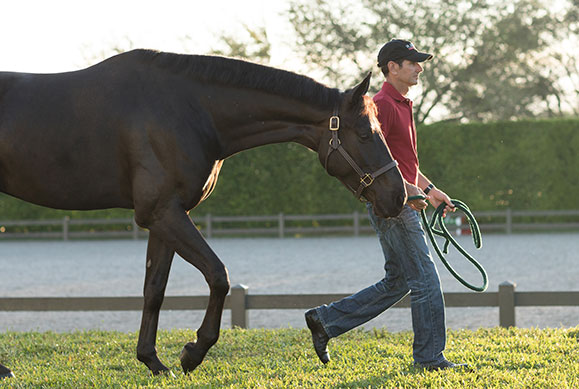
Equine Herpesvirus Supplementation
Supplementing Horses At Risk of Equine Herpesvirus (EHV-1) with Zinc & Lysine
Read More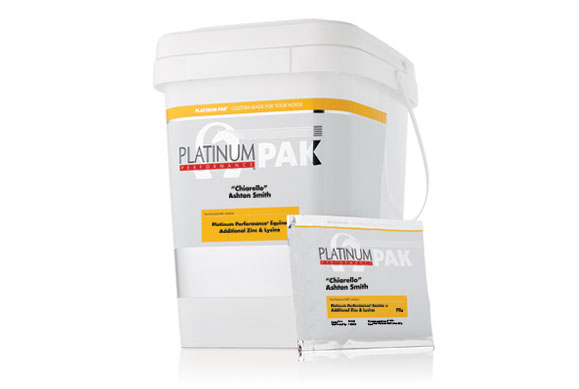
Platinum Performance® Equine + Additional Zinc and Lysine PAK
Equine Wellness with Additional Immune Support
Read More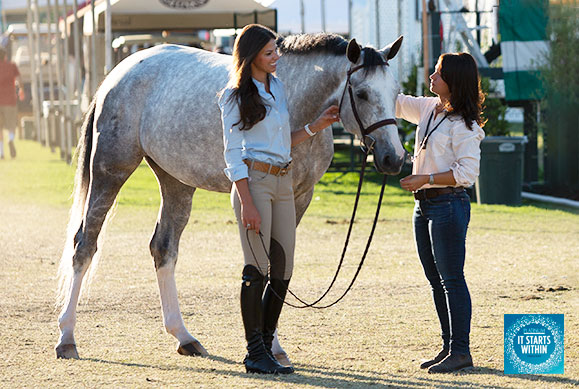
Breaking Down EHV-1
Hear the latest details on EHV-1 from an expert roundtable of veterinarians including Dr. Steve Reed, Dr. Josie Traub-Dargatz and Dr. Lori Bidwell
Listen